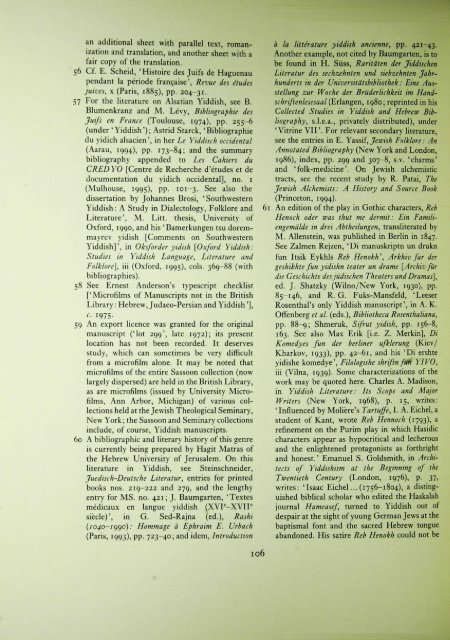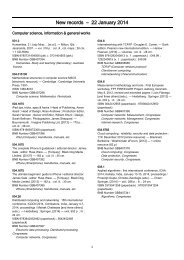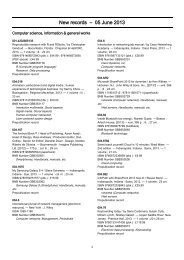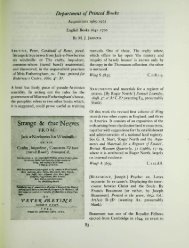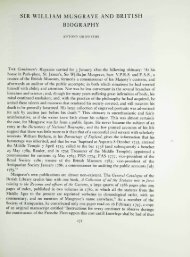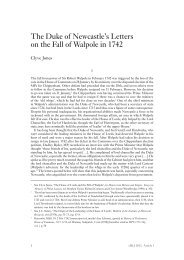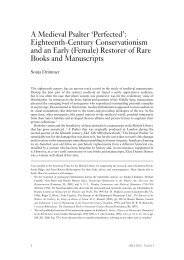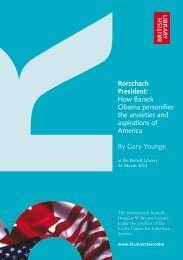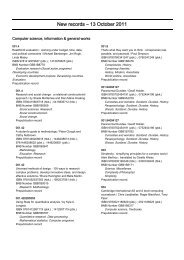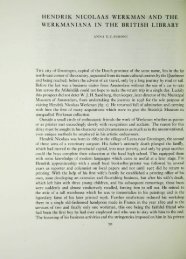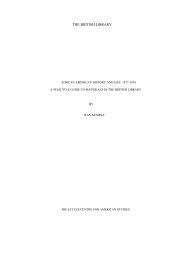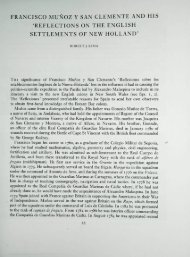YIDDISH MANUSCRIPTS IN THE BRITISH LIBRARY
YIDDISH MANUSCRIPTS IN THE BRITISH LIBRARY
YIDDISH MANUSCRIPTS IN THE BRITISH LIBRARY
You also want an ePaper? Increase the reach of your titles
YUMPU automatically turns print PDFs into web optimized ePapers that Google loves.
an additional sheet with parallel text, romanization<br />
and translation, and another sheet with a<br />
fair copy of the translation.<br />
56 Cf. E. Scheid, 'Histoire des Juifs de Haguenau<br />
pendant la periode fran^aise'. Revue des etudes<br />
juives, X (Paris, 1885), pp. 204-31.<br />
57 For the literature on Alsatian Yiddish, see B.<br />
Blumenkranz and M. Levy, Bibliographie des<br />
Juifs en France (Toulouse, 1974), pp. 255-6<br />
(under 'Yiddish'); Astrid Starck, 'Bibliographie<br />
du yidich alsacien', in her Le Yiddisch occidental<br />
(Aarau, 1994), pp. 173-84; and the summary<br />
bibliography appended to Les Cahiers du<br />
CREDYO [Centre de Recherche d'etudes et de<br />
documentation du yidich occidental], no. i<br />
(Mulhouse, 1995), pp. 101-3. See also the<br />
dissertation by Johannes Brosi, 'Southwestern<br />
Yiddish: A Study in Dialectology, Folklore and<br />
Literature', M. Litt. thesis. University of<br />
Oxford. 1990, and his 'Bamerkungen tsu doremmayrev<br />
yidish [Comments on Southwestern<br />
Yiddish]'', in Oksforderyidish [Oxford Yiddish:<br />
Studies in Yiddish Language, Literature and<br />
Folklore], iii (Oxford, 1995), cols. 369-88 (with<br />
bibliographies).<br />
58 See Ernest Anderson's typescript checklist<br />
['Microfilms of Manuscripts not in the British<br />
Library: Hebrew, Judaeo-Persian and Yiddish'],<br />
c. 1975.<br />
59 An export licence was granted for the original<br />
manuscript ('lot 299', late 1972); its present<br />
location has not been recorded. It deserves<br />
study, which can sometimes be very difficult<br />
from a microfilm alone. It may be noted that<br />
microfilms of the entire Sassoon collection (now<br />
largely dispersed) are held in the British Library,<br />
as are microfilms (issued by University Microfilms,<br />
Ann Arbor, Michigan) of various collections<br />
held at the Jewish Theological Seminary,<br />
New York; the Sassoon and Seminary collections<br />
include, of course, Yiddish manuscripts.<br />
60 A bibliographic and literary history of this genre<br />
is currently being prepared by Hagit Matras of<br />
the Hebrew University of Jerusalem. On this<br />
literature in Yiddish, see Steinschneider,<br />
Juedisch-Deutsche Literatur, entries for printed<br />
books nos. 219-222 and 279, and the lengthy<br />
entry for MS. no. 421; J. Baumgarten, 'Textes<br />
medicaux en langue yiddish (XVI'^-XVIP<br />
siecle)', in G. Sed-Rajna (ed.), Rashi<br />
{1040-iggo): Hommage a Ephraim E. Urbach<br />
(Paris, 1993), pp. 723-40; and idem. Introduction<br />
a la Utterature yiddish ancienne, pp. 421-43.<br />
Another example, not cited by Baumgarten, is to<br />
be found in H. Siiss, Raritaten der Jiddischen<br />
Literatur des sechzehnten und siebzehnten Jahrhunderts<br />
in der Universitatsbibliothek: Eine Ausstellung<br />
zur Woche der Bruderlichkeit im Handschriftenlesesaal<br />
(Erlangen, 1980; reprinted in his<br />
Collected Studies in Yiddish and Hebrew Bibliography,<br />
s.l.e.a., privately distributed), under<br />
* Vitrine VII'. For relevant secondary literature,<br />
see the entries in E. Yzss\{, Jewish Folklore: An<br />
Annotated Bibliography (New York and London,<br />
1986), index, pp. 299 and 307-8, s.v. 'charms'<br />
and ' folk-medicine'. On Jewish alchemistic<br />
tracts, see the recent study by R. Patai, The<br />
Jewish Alchemists: A History and Source Book<br />
(Princeton, 1994).<br />
61 An edition of the play in Gothic characters, Reb<br />
Henoch oder was thut me dermit: Ein Familiengemdlde<br />
in drei Abtheilungen, transliterated by<br />
M. Allenstein, was published in Berlin in 1847.<br />
See Zalmen Rejzen, 'Di manuskriptn un drukn<br />
fun Itsik Eykhls Reb Henokh\ Arkhiv far der<br />
geshikhte fun yidishn teater un drame [Archiv fur<br />
die Geschichte desjudischen Theaters und Dramas],<br />
ed. J. Shatzky (Wilno/New York, 1930), pp.<br />
85-146, and R. G. Fuks-Mansfeld, 'Leeser<br />
Rosenthal's only Yiddish manuscript', in A. K.<br />
Offenberg et al. (eds.), Bibliotheca Rosenthaliana,<br />
pp. 88-9; Shmeruk, Sifrut yidish, pp. 156-8,<br />
163. See also Max Erik [i.e. Z. Merkin], Di<br />
Komedyes fun der berliner ufklerung (Kiev/<br />
Kharkov, 1933), pp. 42-61, and his 'Di ershte<br />
yidishe komedye', Filologishe shriftnfuft YIVO,<br />
iii (Vilna, 1939). Some characterizations of the<br />
work may be quoted here. Charles A. Madison,<br />
in Yiddish Literature: Its Scope and Major<br />
Writers (New York, 1968), p. 15, writes:<br />
' Influenced by Moliere's Tartuffe, I. A. Eichel, a<br />
student of Kant, wrote Reb Hennoch (1793), a<br />
refinement on the Purim play in which Hasidic<br />
characters appear as hypocritical and lecherous<br />
and the enlightened protagonists as forthright<br />
and honest.' Emanuel S. Goldsmith, in Architects<br />
of Yiddishism at the Beginning of the<br />
Twentieth Century (London, 1976), p. 37,<br />
writes: 'Isaac Eichel... (i756-1804), a distinguished<br />
biblical scholar who edited the Haskalah<br />
journal Hameasef turned to Yiddish out of<br />
despair at the sight of young German Jews at the<br />
baptismal font and the sacred Hebrew tongue<br />
abandoned. His satire Reb Henokh could not be<br />
106


